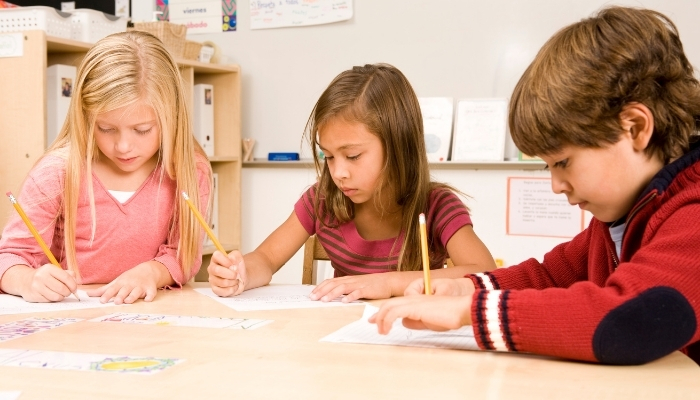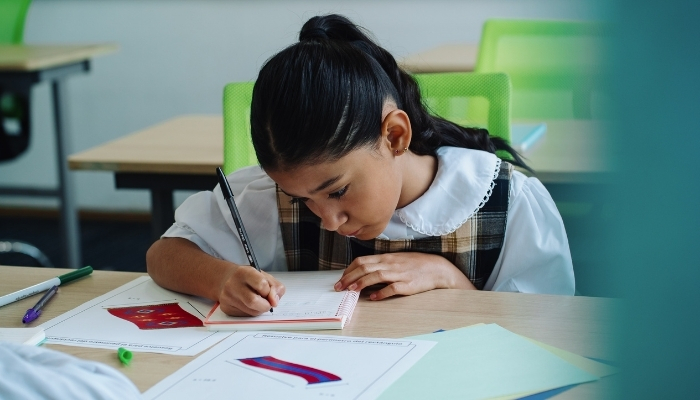Your child sits at the table with a pencil in hand. They want to write about their favorite toy or last weekend's adventure. But the words don't come easily. Letters twist the wrong way. Sounds and symbols refuse to match up. You see the frustration building in their eyes.
This struggle is more common than you think. Early writing skills set the foundation for all future learning. When children miss this foundation in kindergarten, catching up becomes harder each year. Starting with guided writing in kindergarten offers a solution. It provides young learners with the structure they need, all while keeping the process fun and engaging.
In this article, you'll learn what guided writing means for kindergarteners. You'll discover the skills it builds and the materials you need to start. You'll receive a step-by-step lesson format, proven strategies, and practical approaches to accommodate various skill levels. Near the end, you'll know exactly how to help your child become a confident writer.
Key Takeaways
-
Guided writing bridges early literacy learning and independent writing confidence.
-
Simple, consistent routines build habits that make young writers fluent and motivated.
-
Differentiated instruction ensures every child progresses at their own developmental pace.
-
Small challenges are normal; steady support and celebration turn effort into progress.
-
Expert guidance, such as that provided by FunFox Writers Club, makes the process easier for both parents and children.
What Is Guided Writing in Kindergarten?
Guided writing in kindergarten is a structured, small-group instructional approach where children receive direct support as they develop foundational writing skills. A teacher or parent works closely with learners, offering step-by-step guidance, modeling, and immediate feedback throughout the writing process.

At this stage, guided writing lessons focus on essential early literacy skills such as letter formation, sound–letter correspondence, spacing, and sentence construction. The adult models how to write words or sentences aloud, and children then apply those strategies with close support.
Unlike independent writing, guided writing involves continuous interaction. Support is adjusted in real time to match each child’s needs, helping them overcome challenges and celebrate progress.
This method creates a safe space for children to experiment with writing. Mistakes are treated as part of the learning journey, and confidence builds gradually as students gain both skills and self-assurance. Guided writing acts as a bridge between learning to write and writing independently.
What Skills Does Guided Writing Help Develop in Young Learners?
Guided writing supports far more than just putting pencil to paper. It helps your child build the core literacy and thinking skills they’ll carry across every subject. As you guide them through the writing process, you’re helping them grow in confidence, communication, and creativity, one sentence at a time.
Here are the key skills children develop through guided writing:
-
Letter Formation and Handwriting: Your child learns how to form letters correctly, hold a pencil with control, and space out their writing. These fine motor skills are the physical foundation of clear, readable writing.
-
Phonics and Sound–Letter Awareness: Through guided writing, children begin to hear sounds in words and connect them to the right letters. This strengthens their understanding of phonics, spelling, and the link between speaking and writing.
-
Sentence Structure: Guided writing teaches the basics of how sentences work, capital letters at the start, spaces between words, and punctuation at the end. Over time, this structure becomes second nature.
-
Vocabulary and Language Development: Writing provides children with the opportunity to explore and experiment with new words. They learn to describe, explain, and express ideas using language that grows with them.
-
Confidence and Creative Expression: With support, children begin to see themselves as writers. They learn that their thoughts matter and that writing is a way to share those thoughts with the world.
-
Critical Thinking: Writing forces young learners to make choices, such as what to say first, how to explain something, or how to finish a thought. These decisions help develop logic, sequencing, and independent thinking.
Through consistent, supported writing experiences, children strengthen both the mechanics and mindset of writing, turning small daily practice into long-term literacy growth.
Also Read: How to Help Your Child Struggling with Writing Skills
With these skills in mind, consider the simple materials that make practice possible. A few well-chosen tools help you turn each learning goal into a hands-on activity your child can use again and again.
What Materials and Tools Do You Need to Get Started?
You don't need expensive materials to start guided writing. Simple, well-chosen tools work best for kindergarteners. Here's what you need to create a guided writing space:

Essential Writing Tools
-
Pencils with Grips: Fat pencils or regular pencils with rubber grips help small hands control their writing. These tools reduce hand fatigue during practice.
-
Mini Whiteboards and Markers: These are great for practice. Children can write, erase, and try again without fear of mistakes. This quick feedback loop keeps things low-pressure and builds writing stamina.
-
Primary Writing Paper: Use paper with wide lines and a dotted middle line to guide letter formation. It helps kids understand where each part of the letter goes, building muscle memory over time.
Learning Support Materials
-
Word Cards: Create cards with high-frequency words like the, and, is, and can. These tools help children quickly recognize familiar words and use them correctly in sentences.
-
Alphabet Charts: Display a chart showing how to form each letter, uppercase and lowercase. Add visual cues (like A for apple) to reinforce letter-sound connections while writing.
-
Sentence Starters: Use simple phrase cards like I like…, My favorite…, or I can…. These give children a starting point so they’re not stuck staring at a blank page.
-
Picture Prompts: Photos, drawings, or clip art can inspire reluctant writers to get started. Visuals provide kids with something tangible to write about, especially if they’re not yet confident in spelling or idea generation.
You don’t need to buy everything new; in fact, many guided writing materials can be made at home. Word cards can also be created with cardboard and markers, alphabet charts are often available as free downloads, and picture prompts can come straight from old magazines. As you gather supplies, try setting up a small, dedicated writing space.
Keep materials organized in bins or baskets, and make sure everything is easy for your child to reach. A simple, well-organized space helps your child stay focused, confident, and excited to write.
What Does a Typical Guided Writing Lesson Look Like?
A guided writing lesson is a tightly structured routine designed to help young learners build writing skills, one small, supported step at a time. Each phase serves a unique purpose: to model, scaffold, and slowly release responsibility as children grow in confidence and ability.

Here’s what a practical guided writing session looks like, how long it takes, and what each stage is meant to accomplish.
Step 1: Mini-Lesson (5 minutes)
Set a Clear Focus
The mini-lesson is where you introduce the writing goal for the day. This could be a mechanical skill (like spacing or punctuation), a structural element (like adding a verb), or a conceptual one (like staying on topic). Keep it highly focused, one clear, actionable teaching point per lesson.
You should always model the skill visually and verbally. Write in front of the group, speaking your thoughts aloud as you form each word or sentence. This makes your invisible process visible, teaching children not just what to do, but how to think like writers.
-
Example: “Today we’re writing about things we like. I’m going to write ‘I like apples.’ Watch how I start with a capital I. Then I put a space. I write ‘like’ and then another space before writing ‘apples.’ And I end with a period.”
Why it matters: Young learners need repetition and clarity. A short, consistent teaching point helps avoid cognitive overload and creates habits over time.
Step 2: Shared Writing (7–10 minutes)
Build it Together
In this phase, students assist with content generation, while you handle the writing. Ask open-ended questions that prompt ideas, then write their suggestions in real time on chart paper or a whiteboard, all while reinforcing conventions (like sentence structure and spelling) as you go.
This is also a chance to show flexibility. If a child says, “I like the zoo,” but struggles to explain why, ask prompting questions:
“What did you see at the zoo? Can we add a detail?”
Why it matters: Shared writing helps bridge the gap between watching and doing. It gives children a voice while still providing structure, showing them how their spoken language connects to written form.
-
Pro tip: Pause frequently to ask children to predict what comes next, correct spacing, or choose punctuation. That interaction deepens engagement and understanding.
Step 3: Guided Practice (10–15 minutes)
Support While They Try
Now, students write their own piece based on the skill you modeled. Your role shifts to roaming coach. Sit with individuals or small groups, offering help as needed. Let them struggle productively before stepping in.
Different students will need different kinds of support. One may need help stretching out sounds to spell. Another may need help remembering to use spaces. Tailor your feedback to the child, not just the task.
Example supports:
-
“Say the word slowly — what sound do you hear first?”
-
“Let’s count the words in your sentence and check if you’ve written them all.”
Why it matters: This is where the learning sticks. Children build confidence as they try, fail, and adjust with real-time coaching. It's also where you gather insight into what to teach next.
Step 4: Independent Try (5–7 minutes)
Let Go a Little
Now it’s time for students to write with no immediate help. They apply what they’ve just practiced and begin to take ownership of their writing. Stay available for clarification, but avoid overcorrecting. The focus here is independence, not perfection.
You’ll likely see a range of output, and that’s okay. Some may write a complete sentence; others might get one word down. What matters is that they are making decisions and taking risks as writers.
Why it matters: This phase builds writing stamina and autonomy. It reinforces that writing is a process, and that every attempt is progress.
Step 5: Sharing and Celebration (3–5 minutes)
Reinforce Purpose and Pride
End the session by having students share their writing with a peer, the group, or even just with you. Focus your praise on specific effort or growth:
“You remembered to use finger spaces!”
“Last week you wrote one word. Today you wrote three!”
You can display their work on a wall, let them read aloud, or ask them to circle their favorite part of their sentence.
Why it matters: Sharing gives writing a purpose and builds intrinsic motivation. Children see themselves as writers when they feel seen and valued.
Sample Lesson Plan: Writing "I Can" Sentences
Objective: Write a complete sentence using a high-frequency sentence starter.
Materials: Mini whiteboards, markers, “I can” word cards, and alphabet charts.
-
Mini-Lesson: Model writing "I can run," pointing out each part (capital letter, spacing, ending punctuation).
-
Shared Writing: Ask students for other action words and build “I can…” sentences together.
-
Guided Practice: Students write their own "I can" sentence with your help.
-
Independent Try: Students write one or two new sentences without support.
-
Sharing: Each child reads one sentence to the group and receives specific praise.
This five-step structure helps young writers by providing just enough support at each stage, and then gradually stepping back. Over time, students begin to internalize the structure, apply it on their own, and write with increasing fluency and confidence.
With a lesson framework in place, refine how you teach within each step. The right strategies help you scaffold, prompt, and motivate so each activity becomes a meaningful learning moment.
Also Read: Best Creative Writing Tools for Kids in 2025
What Are the Best Strategies for Supporting Writing in Kindergarteners?
Supporting early writers is all about giving them the confidence, structure, and tools they need to begin expressing their thoughts on paper. The most effective strategies balance support and independence, helping children grow into capable, motivated writers.

Below are several key approaches that you can use in the classroom or at home. These techniques work best when combined and tailored to each child's individual needs.
1. Scaffolding: Support First, Then Step Back
Scaffolding means providing high levels of support early on and gradually reducing that support as skills develop. This method builds confidence by helping children experience success while still being challenged.
You can scaffold writing in several ways:
-
Hand-over-hand guidance: Gently guide a child's hand to help them form letters. This physical support can be phased out as their fine motor control improves.
-
Verbal prompts: Ask guiding questions such as “What sound do you hear at the start of that word?” or “What do we need at the end of a sentence?” This encourages self-correction and active thinking.
-
Non-verbal cues: Tap the space on the paper where the next word should go, or point to a word wall when a child hesitates. These subtle signals keep them on track without disrupting their flow.
Scaffolding works best when it’s responsive. Watch what each child needs and adjust your support accordingly.
2. Sentence Starters: Help Them Begin with Confidence
The hardest part of writing for many children is getting started. Sentence starters provide a structure that helps them launch into their ideas without fear of the blank page.
Start with simple, high-frequency frames:
-
I see ___
-
I like ___
-
My ___ is ___
As children grow more confident, introduce more detailed starters:
-
My favorite ___ is ___ because ___
-
I can ___ and ___
-
Yesterday I ___
Keep these visible during writing time. When children have a familiar structure to lean on, they focus more on their ideas and less on how to begin.
3. Anchor Charts: Build a Visible Writing Toolkit
Anchor charts act as visual reminders of key writing skills. When children can refer to them independently, it reduces interruptions and builds self-reliance.
Helpful anchor charts to create with your students include:
-
The parts of a sentence (capital letter, finger spaces, period).
-
Common sound-spelling patterns (e.g., ch, sh, th).
-
High-frequency words or sight words.
-
Descriptive vocabulary sorted by category (colors, feelings, actions).
Whenever possible, create these charts with children rather than for them. This involvement helps them internalize the information and increases engagement.
4. Visual Aids: Support Thinking and Language
Visuals are beneficial for young or reluctant writers. They stimulate ideas and provide essential support for vocabulary, spelling, and sentence construction.
Consider using:
-
Picture dictionaries that children can flip through to find words.
-
Photo prompts to inspire writing about familiar activities or scenes.
-
Posters of pencil grip or letter formation for motor memory.
-
Word walls with images next to each word, organized by theme or subject.
These tools make writing feel more accessible and reduce the frustration of not knowing how to express their thoughts.
5. Sound Boxes: Build Phonemic Awareness and Spelling Skills
Sound boxes (also known as Elkonin boxes) are a powerful tool for helping children connect sounds to letters. You draw one box for each sound in a word, and the child fills in the letters as they segment the word.
For example, for the word “cat,” draw three boxes:
-
First box: c
-
Second box: a
-
Third box: t
This visual framework strengthens a child’s ability to hear, isolate, and record sounds, an essential step toward spelling independence.
Each of these strategies supports a different piece of the writing process. The key is to mix and match based on what your students or children need that day.
The above-mentioned strategies can be even more powerful when tailored to each child's individual needs. Differentiation helps you match support and challenge so that every child moves forward from exactly where they sit today.
How Do You Adapt Guided Writing for Different Skill Levels?
Kindergarten classrooms contain children at vastly different stages. Some children arrive knowing letter names and sounds. Others have never held a pencil for writing. Your instruction must flex to meet everyone's needs.

Understanding Developmental Stages
Identify where each child stands in terms of writing development. Some children make random marks. Others write recognizable letters. Still others compose simple sentences. All these stages are normal in kindergarten.
Don't expect all children to do the same thing at the same time. Group children flexibly based on current skills. Change groups as children develop.
Differentiation for Struggling Writers
Children who struggle need more explicit instruction. Break skills into smaller steps while providing more modeling and practice time.
Strategies That Help:
-
Use multisensory approaches. Let children trace letters in sand or shaving cream before writing on paper.
-
Provide hand-over-hand support longer. Physical guidance builds muscle memory.
-
Focus on fewer letters at a time. Master a small set before introducing more.
-
Accept invented spelling. The act of trying matters more than perfect spelling at this stage.
-
Use pictures or verbal dictation when motor skills lag behind ideas. This prevents frustration.
Give these children more time to think before expecting written output. Reduce the amount of writing required while maintaining quality expectations.
Extension for Advanced Writers
Some children arrive ready for more challenge. They need extension activities that challenge and advance their thinking.
Ways to Extend Learning:
-
Increase sentence length and ask for two or three sentences instead of one.
-
Introduce conjunction words like "and," "but," and "because,” and help children combine simple sentences.
-
Add descriptive words and challenge children to use color, size, or feeling words.
-
Vary sentence starters and try to move beyond "I" sentences to other subjects.
-
Introduce basic punctuation like question marks or exclamation points.
Advanced writers can also help other children as peer teaching reinforces their own understanding while building community.
Grouping Strategies
Form small groups based on similar skill levels. This allows for targeted instruction and is designed for groups of three to five children.
Rotate through groups during guided writing time. Work intensively with one group while others practice independently or with partners. Plan different activities for each group based on their needs.
Keep groups flexible. Move children as they develop new skills. Avoid permanently labeling anyone as "low" or "high."
Even within small groups, individual needs vary. Be prepared to make on-the-spot adjustments. Some children may benefit from larger paper with wider lines, while others might do better with textured paper that they can feel.
Also Read: 50 Creative Writing Exercises to Inspire Younger Writers
What Challenges Might You Face, and How Can You Solve Them?
Even with the best planning, challenges arise during guided writing. Knowing common problems and their solutions helps you respond confidently when issues appear.

Challenge 1: Children Refusing to Write
Some children say, "I can't" or "I don't know what to write." This resistance often masks fear or genuine uncertainty.
Solutions to try:
-
Start with drawing. Let children draw their ideas first, then write about the picture.
-
Offer specific choices. "Do you want to write about your pet or your favorite food?" Choices reduce overwhelm.
-
Accept shorter responses initially. One word or one sentence counts as success.
-
Sit beside the child and write together. Your physical presence provides comfort.
-
Use high-interest topics. Write about dinosaurs, superheroes, or whatever excites the child.
-
Celebrate any attempt. Focus on effort rather than perfection.
The key is reducing pressure while maintaining expectations. Make writing feel safe and achievable.
Challenge 2: Inconsistent Letter Formation
Children often form letters incorrectly, making them backwards or starting from the wrong point.
Solutions to try:
-
Use multi-sensory practice. Trace letters in sand, form them with playdough, or write them large with arm movements.
-
Provide directional arrows on letter cards. Show exactly where to start and which direction to move.
-
Practice in isolation first. Master letter formation before expecting it during composition.
-
Give physical cues. Touch where the pencil should start. Guide the hand through correct movements.
-
Focus on a few letters at a time. Don't try to fix everything at once.
-
Use verbal cues consistently. "Big line down, across, across" for capital E, repeated the same way each time.
Remember that letter formation takes time to solidify. Consistent practice with proper form eventually creates correct habits.
Challenge 3: Attention and Behavior Issues
Young children have short attention spans. Maintaining focus during writing proves challenging for many.
Solutions to try:
-
Keep lessons brief. Twenty to thirty minutes is often the maximum for kindergarteners.
-
Build in movement breaks. Do a quick stretch or action song between activities.
-
Use sensory tools. Some children focus better with a fidget item or while sitting on a therapy ball.
-
Make activities highly engaging. Use props, puppets, or other concrete materials.
-
Set clear, positive expectations. Tell children what to do rather than what not to do.
-
Provide immediate positive feedback. Catch children doing well and acknowledge it right away.
If a child can't focus despite these strategies, shorten their writing time. Better to have five productive minutes than twenty frustrating ones.
Challenge 4: Wide Skill Gaps in Mixed Groups
When children at very different levels work together, meeting everyone's needs can be challenging.
Solutions to try:
-
Use flexible grouping. Work with similar-ability groups for part of the time and mixed groups at other times.
-
Assign different expectations. One child writes a word while another writes a sentence on the same topic.
-
Create tiered prompts. Offer simple and complex versions of the same writing task.
-
Use peer helpers. Pair stronger writers with those who need more support.
-
Provide differentiated materials. Give easier word cards to some children, more complex ones to others.
-
Plan multiple activities. Have extension work ready for children who finish quickly.
Accept that not everyone will produce the same output. Progress matters more than uniformity.
If navigating these solutions feels overwhelming, consider the built-in options that provide packaged expertise and consistency. Programs that combine small groups, trained teachers, and structured practice can dispel assumptions and maintain momentum.
How Does FunFox Bring Guided Writing to Life for Your Child?
You now understand how powerful guided writing can be for building early literacy skills. You know the structure, strategies, and materials you need. But implementing everything consistently takes time, expertise, and planning.

Many parents want to support their child's writing but feel overwhelmed by where to start. This is where FunFox Writers Club makes a real difference. We bring expert guided writing instruction directly to your child in a way that fits your family's life.
-
Small Group Learning That Actually Works
Our classes never exceed six students. This small size means your child gets individual attention during every session. Teachers notice when your child struggles with letter formation. They catch spelling patterns they need to work on and celebrate each breakthrough immediately.
Your child isn't lost in a large classroom. They're seen, known, and supported by a teacher who understands their specific needs.
-
Trained Teachers Using Proven Methods
FunFox teachers receive specialized training in our proprietary teaching approach. They know how to make writing engaging for young learners. They understand developmental stages and adjust instruction accordingly.
Every teacher uses the same guided writing structure you've learned about in this article. They model skills clearly. They provide scaffolded support. They gradually build independence while your child benefits from expert instruction designed specifically for early writers.
-
Weekly Sessions That Build Strong Habits
Consistency matters for skill development. FunFox provides weekly 60-minute sessions throughout the school term. This regular practice helps writing skills become automatic.
Your child works on punctuation, grammar, spelling, and creative expression. They learn different writing genres, including narratives, poetry writing, and personal stories. Each session builds on the previous one, creating steady progress.
-
Flexibility That Works for Busy Families
All classes happen online via Zoom. Your child learns from home at a time you choose. No driving to tutoring centers. No rushing after school. The convenience of online learning is paired with the effectiveness of small-group instruction.
All classes are recorded, so your child can review lessons or catch up if they're absent.
-
Regular Feedback on Your Child's Progress
FunFox provides process-based feedback during every lesson. Teachers comment on your child's work, guiding improvement. You receive updates about your child's developing skills.
Each term includes a parent-teacher meeting. Discuss your child's progress, strengths, and areas for growth. Discover specific strategies you can use at home to support your child's learning.
With FunFox Writers Club, your child learns while having fun. Our teachers use games, creativity, and engagement strategies that keep kindergarteners excited about writing.
Conclusion
Teaching young writers is one of the clearest investments you can make in a child’s future. What matters most isn’t perfection today but the habit of trying, the joy of discovery, and the quiet confidence that follows every small success. When you focus on steady practice and meaningful encouragement, you give your child a lifelong advantage that shows up in reading, thinking, and communicating.
If you’d like a practical next step that takes the planning and execution off your plate, FunFox Writers Club can help. Think of it as a friendly, expert-supported way to make your kid’s writing practice regular, engaging, and progress-driven, so you don’t have to do it alone.
Hop on a trial class with FunFox Writers Club today and watch your kid start writing with more confidence and joy.
FAQ’s
1. What are the four steps for guided writing instruction?
The four steps are modeling the writing process, shared writing with teacher support, guided group practice, and independent writing, where students apply skills with minimal assistance.
2. What are the five components of guided reading?
The five components are introducing the text, reading with teacher support, discussing comprehension, teaching specific reading strategies, and extending learning through follow-up writing or vocabulary activities.
3. What age group is guided writing best for?
Guided writing is best for early learners aged 4 to 7, typically in preschool through first grade, when foundational literacy and sentence construction skills are being developed.
4. What are some examples of guided writing prompts?
Examples include “Write about your favorite playground activity,” “Describe your pet,” or “What did you do on the weekend?” Prompts focus on familiar, experience-based topics for young writers.















